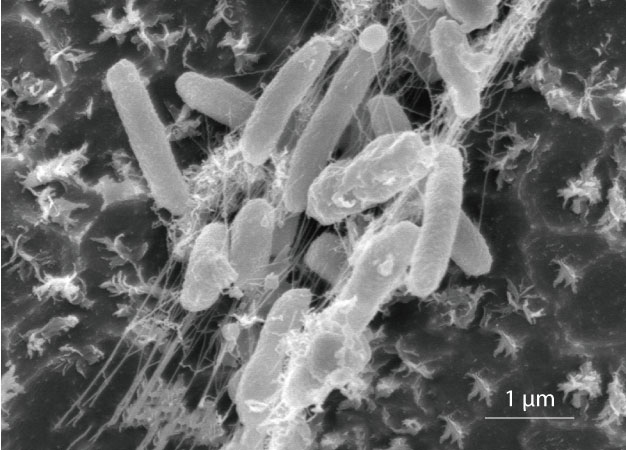New discovery could lead to a safer solution to plastic pollution
Published online 28 April 2016

The bacterium Idoenella sakaiensis feeds on plastic bottles for energy and carbon.
© 2016 Kohei Oda, Kyoto Institute of Technology
The discovery of a bacterium that feeds on polyethylene terephthalate (PET), by a team of Japanese scientists, has been hailed as a potential international breakthrough in dealing with the major pollution caused by the tough plastic1.
The bacterium, named Idoenella sakaiensis, pitted the surface of a PET film with holes within just 60 hours. In six weeks, it almost completely degraded the plastic.
"This is the first PET-degrading bacterium found," says Kenji Miyamoto, an associate professor in the Department of Biosciences and Informatics at Keio University and one of the study's authors. The team plans to build on the discovery "to develop a new and nature-friendly system" of recycling PET.
More than 55 million tons of PET is produced each year to make products such as soda bottles, clothing and even car bumpers. First manufactured 70 years ago from petroleum products, PET's crystalline structure is difficult to break down. With only 14 per cent of plastic recycled, most of it ends up contaminating the environment, especially rivers and oceans.
The team, led by Kohei Oda of the Kyoto Institute of Technology, went in search of a microorganism that could degrade PET so it could be recycled without posing an environmental burden.
They collected 250 samples of contaminated soil, waste water and sludge from a PET bottle recycling factory in Osaka. Each sample was screened for microorganisms that could grow on the polymer. To make it easier for the bacteria to consume the polymer, they used an amorphous form of PET film, heat treated at 260 degrees Celsius to break down its crystalline structure.
In one sample, a consortium of microbes degraded the PET film and catabolized 75 per cent of the carbon into carbon dioxide. The researchers isolated the PET-eating bacterium from the sample.
"We were very excited," says Miyamoto. Further investigations found that I. sakaiensis had evolved to use PET as its major source of energy and carbon. Electron microscope photographs showed clusters of bacterial cells, resembling tiny grubs, connected to the PET film and each other by thread-like appendages (see image).
Through DNA analysis the researchers discovered that the bacterium uses two enzymes ― PETase and MHETase ― to break down the plastic into its basic building blocks.
In follow-up research, Miyamoto says the team intends to determine the three-dimensional structure of the two enzymes "in order to know their reaction mechanism". The enzymes could potentially be manufactured and used to convert heat-treated PET waste into environmentally benign and useful materials.
Reference
- Yoshida, S. et al. A bacterium that degrades and assimilates poly(ethylene terephthalate). Science 351, 1196-1199 (2016). | article